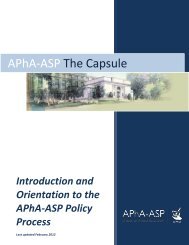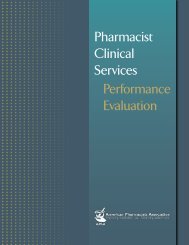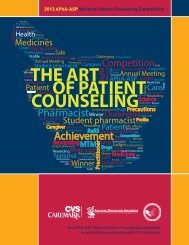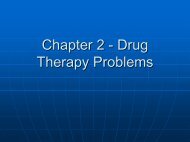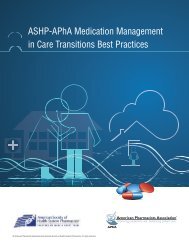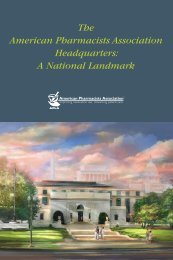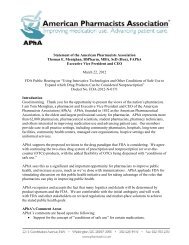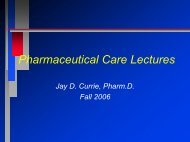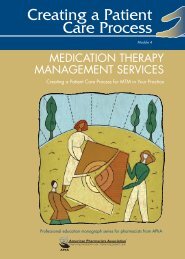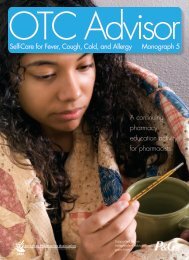Community Pharmacist Preceptor Education Program - Library
Community Pharmacist Preceptor Education Program - Library
Community Pharmacist Preceptor Education Program - Library
- No tags were found...
Create successful ePaper yourself
Turn your PDF publications into a flip-book with our unique Google optimized e-Paper software.
success. It is better to identify and address problems earlyin the rotation than to wait until it is too late to rectify thesituation.Concluding a RotationThe end of a rotation can be an exciting and hectictime. Student pharmacists may feel pressure to completeall of their activities on time. <strong>Preceptor</strong>s are responsible forcompleting evaluations and administrative requirementsfor the school. As part of the final assessment of yourstudent pharmacist, reflect on whether he or she is preparedto progress to the next level of education or to enter theworkforce.At the end of each rotation, set aside time with thestudent pharmacists to discuss your impressions of theirperformance and obtain their views of the experiences. Youcan begin this discussion by thanking them for their effortsduring the rotation, and then remark on specific outcomesthat impressed or pleased you. Also identify areas that youbelieve they can improve during their continued studiesand as they begin their careers. Aim to conclude rotationson a positive note and describe the student pharmacists’positive qualities and how they will help them becomegood pharmacists.Attend to any administrative responsibilities that youhave to report about the outcomes of the rotation to theschool of pharmacy and to your site’s management.<strong>Preceptor</strong>s should perform continuous qualityimprovement activities for the rotation, just as they dofor clinical activities. Reflect on what worked well duringthe rotation, and where challenges arose. Consider whatcould be done to enhance or improve these aspects of therotation. Schools generally require student pharmacists toevaluate their preceptors. These evaluations can providevaluable feedback that you can use to perform continuousquality improvement activities for future rotations at yoursite. It may not be necessary to make major changes basedupon a single evaluation, but you should consider revisionswhen you see a pattern of suggested improvements.Finally, as you conclude the rotation, be proud ofyourself! You have performed a valuable service not onlyto your student pharmacist but also to the profession ofpharmacy and to public health by helping train the nextgeneration of pharmacists.ConclusionBeing a preceptor is often a very rewarding experience,allowing preceptors to act as mentors to studentpharmacists, and providing an opportunity for practicingpharmacists to give back to the profession and theircommunity. However, adequate preparation is required forsuccess. New preceptors should ensure that they carefullyplan the rotation in conjunction with the school’s officeof experiential education to design activities that meet thegoals and objectives of the rotation that they will conductfor the school.Effective preceptors are skilled and committedindividuals who care about serving as positive role modelsfor future pharmacists and devote the necessary attention tothe development of the students. In addition, it is essentialto maintain open lines of communication and providefeedback to the student pharmacist throughout the rotation.Clearly stating expectations to the student, and clarifyingany issues with the experiential program administrativeteam prior to or at the beginning of the rotation will help thestudent pharmacist achieve excellence. Providing ongoingsupport and guidance throughout the rotation, and a fairassessment at its completion, are essential responsibilitiesof the preceptor.Through serving as a preceptor, practicing pharmacistshave a great opportunity to help shape the future of thepharmacy profession as patient care roles continue toexpand. Thank you for your commitment to this process.References1. Joint Commission of Pharmacy Practitioners Writing Team. JCPP Future Vision ofPharmacy Practice. Final Version. November 10, 2004. Available at: http://www.aacp.org/Docs/MainNavigation/Resources/6725_JCPPFutureVisionofPharmacyPracticeFINAL.pdf. Accessed April 18, 2007.2. Accreditation Council for Pharmacy <strong>Education</strong>. Accreditation Standards andGuidelines for the Professional <strong>Program</strong> in Pharmacy Leading to the Doctor ofPharmacy Degree. 2006. Available at: http://www.acpe-accredit.org/standards/default.asp. Accessed January 3, 2007.3. Nemire RE, Meyer SM. Educating students for practice: educational outcomes andcommunity experience. Am J Pharm Educ. 2006;70(1):Article 20.4. Epstein RM, Hundert EM. Defining and assessing professional competence. JAMA.2002;387:226–35.5. Reynolds JR, Briceland LL, Carter JT, et al. Experiential education delivery—ensuringsuccess through support and development of the faculty and administrative team:report of the 2004–2005 Professional Affairs Committee. Am J Pharm Educ.2005;69(5):Article S9.6. Dugan BD. Enhancing community pharmacy through advanced pharmacy practiceexperiences. Am J Pharm Educ. 2006;70(1):Article 21.7. American Association of Colleges of Pharmacy Academic-Practice PartnershipInitiative. Pilot Project to Profile Exemplary Advanced Practice Experience Sites.September 14, 2006. Available at: http://www.aacp.org/Docs/MainNavigation/Resources/7681_APPIAPESPSProject.pdf. Accessed January 11, 2007.8. McDonough RP, Bennett MS. Improving communication skills of pharmacystudents through effective precepting. Am J Pharm Educ. 2006;70(3):Article 58.9. Smith RE, Kerr RA, Nahata MC, et al. AACP Engaging Communities: AcademicPharmacy Addressing Unmet Public Health Needs. Report of the 2004–05Argus Commission. Available at: http://www.aacp.org/Docs/AACPFunctions/Governance/6822_2005ArgusreportEngaging Communities.doc?DocTypeID=4&TrackID=www.aacp.org/search/search.asp. Accessed July 7, 2006.10. Zweber A. Cultural competence in pharmacy practice. Am J Pharm Educ.2002;66:172–6.11. Thomas RA. Developing structured-learning exercises for a community advancedpharmacy practice experience. Am J Pharm Educ. 2006;70(1):Article 23.12. Bonwell CC, Eison JA. Active Learning: Creating Excitement in the Classroom.ASHE-ERIC Higher <strong>Education</strong> Reports Series. Vol. 20. Hoboken, NJ: John Wiley &Sons; 1991.13. Koenigsfeld CF, Tice AL. Organizing a community pharmacy practice experience.Am J Pharm Educ. 2006;70(1):Article 22.14. Pharmacy Value Alliance. <strong>Pharmacist</strong> opportunity statements. Available at: http://www.pharmacyvaluealliance.org/pdf/oppstatement.pdf. Accessed March 12, 2007.15. Calomo JM. Teaching management in a community pharmacy. Am J Pharm Educ.2006;70(2):Article 41.16. Beardsley RS. Chair report of the APhA-ASP/AACP-COD Task Force onProfessionalization: enhancing professionalism in pharmacy education andpractice. Am J Pharm Educ. 1996;60:26S–28S.17. Medical Professionalism Project. Medical professionalism in the new millennium:a physician charter. Ann Intern Med. 2002;136:243–6.18. Hammer DP, Mason HL, Chalmers RK, et al. Development and testing of aninstrument to assess behavioral professionalism of pharmacy students. Am JPharm Educ. 2000;64:141–51.19. American <strong>Pharmacist</strong>s Association. Code of Ethics for <strong>Pharmacist</strong>s. October 27,1994. Available at: http://www.aphanet.org/AM/Template.cfm?Section=Home&CONTENTID=2654&TEMPLATE=/CM/HTMLDisplay.cfm. Accessed January12, 2007.20. Stern DT, Papadakis M. The developing physician—becoming a professional.N Engl J Med. 2006;355:1794–9.21. Iwanowicz SL, Marciniak MW, Zeolla MM. Obtaining and providing healthinformation in the community pharmacy setting. Am J Pharm Educ. 2006;70(3):Article 57.22. Hammer D. Improving student professionalism during experiential learning. Am JPharm Educ. 2006;70(3):Article 59.23. Kleffner JH. Becoming an Effective <strong>Preceptor</strong>. Updated 2004. Available at:http://www.utexas.edu/pharmacy/general/experiential/practitioner/becoming.pdf.Accessed April 9, 2007.24 APhA and NACDS Foundation



